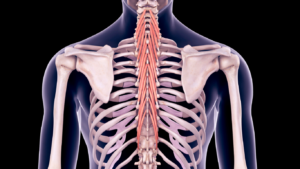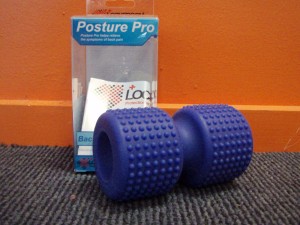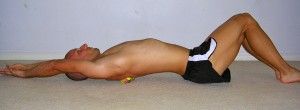Written by Physio Rob Taylor
Your thoracic spine is the middle section of your vertebra between your neck and lower back and composes 12 thoracic vertebra and your rib cage. Thoracic mobility can be thought of the available movement or motion of this region of our body, and is very important for achieving good posture to ensure you don’t get pain from poor posture, and it is also essential for most sporting performances.
Modern life style and certain sports can lead to stiffness and poor movement which increases the natural “kyphosis” (rounding curve) of the thoracic spine which can lead to decreased sporting performance, injury and pain.
 Thoracic issues can affect 4 main things:
Thoracic issues can affect 4 main things:
- Posture
- Upper limb movements
- Lower limb movements
- Breathing
Posture is something we have all heard of and hours spent at desk jobs, on the internet, studying and certain sports like cycling can lead to negative changes in posture. With a stiff thoracic spine the natural rounded curve increases and the ability to extend (straighten up) and rotate is decreased. This leads to a neck and head sitting forward (Poke neck posture) which is associated with neck pain and headaches. Below the thoracic spine the pelvis often ends up in an anterior (forwards) tilt and the lower back more rounded in the reverse direction (lordotic) to compensate for the thoracic spine posture. This is associated with lower back pain especially in people with previous lumbar disc injuries.
Changes in long term posture can change the way the upper and lower body move. Decreased thoracic mobility and poor posture can affect people in any sport but has a large role to play in swimmers, golfers, kayakers and tennis players and any other sport that requires good thoracic extension or rotation (twisting). Decreased thoracic mobility decreases the range of shoulder movements particularly elevation (lifting overhead) by changing the position of the shoulder blade on the rib cage. A simple test is to sit slouched and lift your arms up, then re test sitting up straight and in good posture. If you notice a difference in how far your arms lift behind your ears from one position to the next, then chances are your thoracic mobility needs improving.
One major area I see often when working with Crossfit athletes and Powerlifters is problems with squatting associated with stiff thoracic spines. Decreased thoracic mobility makes it harder to get under a bar, leading to wider hand placements (and too wide does not maximise power from the lower limbs). Secondly, a lot of missed lifts occur because the chest is unable to open up due to stiffness in the thoracic spine and decreased strength in upper back muscles which pushes the weight forward making the lift harder.
Changes to lower limb mechanics due to thoracic spine stiffness can be more subtle than seen in upper limb. An increased thoracic curve leading to increased lumbar spine lordosis (arch) and an anterior pelvic tilt changes the forces on the lower limb which can have particularly detrimental effects in any sports that involve running.
One new area that is becoming more researched and is linked to thoracic spine stiffness is changes to breathing. Normal breathing requires the ribs to move like a bucket handle (they lift to the sides). The stiffer the rib joints are where they join at the spine means less movement can occur at this joint and this can make it more difficult to take a breath when higher breathing rates and breathe volumes are required potentially less air breathed. This factor is made worse in cardiovascular-based sports that require sitting or being bent over such as rowing, kayaking or cycling (particularly in a time trial position). This can be demonstrated by placing your hands on your hands on your lower ribs and taking a deep breathe in good posture and in a slouched rounded posture. The stiffer the spine or the more rounded the posture the less the ribs are able to expand properly which is important in sporting performance.
How can physio help with Thoracic Spine Stiffness?
A physio is trained to assess all vertebra movements and posture. A thorough assessment should involve thoracic spine movements such as extensions, rotation, side bending and rib expansion. Other things may include shoulder movements such as streamline in swimmers, neck movements and lumbar spine movements as well. Sitting and standing posture will also be assessed. If there are specific sports positions that require assessing such as time trial position or boat position this should be assessed as well.
Treatment for a stiff thoracic spine can include joint mobilisations, soft tissue massage, postural exercises, strength exercises and self stretching. Self stretching is very important and something that should be included in a regular stretching program for all athletes but more so for people at risk of problems such as desk workers, cyclists, swimmers, kaykers and other sports that require good thoracic mobility and posture.
Some example stretches and devices you can use include:
Foam Roller used as a Thoracic roller
 Both Foam Rollers and Posture Pro’s can be purchased at either of our clinics.
Both Foam Rollers and Posture Pro’s can be purchased at either of our clinics.
To learn how to use these aids correctly, or if you have any further questions about thoracic spine mobility, come and visit one of our experienced Physiotherapists. We can show you how we can assist you achieve great thoracic mobility and ultimately improve your comfort and sports performance. Call us on 07 5500 6470 or simply book online



































